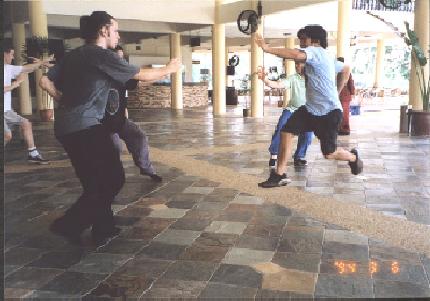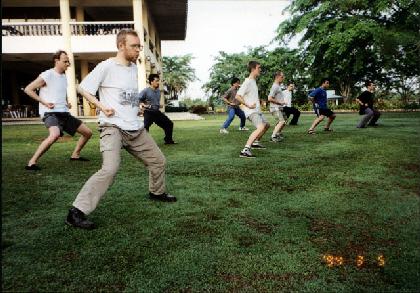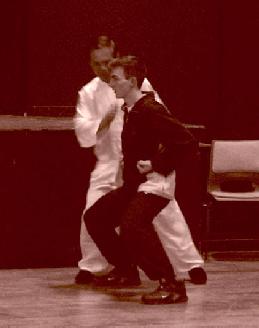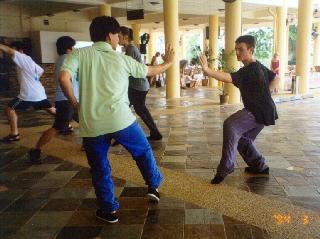August 2002 (Part 1)
SELECTION OF QUESTIONS AND ANSWERS

Wong Chun Nga “flying” in to attack Dan Hartwright during an Intensive Shaolin Kungfu Course in Malaysia in April 2002. (Photo from Dan)
Question 1
Any master of any discipline would hate the fact that I never finish what I begin. I trained a year at some art that takes a lifetime to master and I quit. I wasted so much time training in arts I have never mastered and will never master. Or so I thought.
— NIcolas, Canada
Answer
Masters do not hate the fact or hate the students who drop off half way. Some lament over the fact, but many are indifferent. In the first place, most masters are not keen to teach. It is only self-glorified people who imagine themselves as future saviours of the world that they think masters are dying to teach them if only they express their wish to learn, and they expect the masters to house and feed them, and to teach them according to the ways they like.
This misguided view, for some reasons, is quite prevalent in the West. In the East most students know it is a rare opportunity to learn from a master, because masters are very rare. Here, of course I am referring to true masters — those who have mastered the genuine arts.
True masters are not keen to teach, not because they are selfish but because they know fully well that very, very few people have the type of perseverance and endurance that they demand of their students. They regard teaching as a heavy responsibility, like the responsibility of a father towards his children. Indeed, the term “sifu” literally means “teacher-father”. They do not want to waste their time and effort on students who are likely to drop off half-way.
In contrast, today there are many bogus masters who take teaching as an opportunity — an opportunity to be famous as well as to exploit their female students sexually under the pretext of injecting power — something a true “teacher-father” would never think of.
Question 2
A river always flows towards the sea, no matter the waterfalls, the turns, the twists. Am I wrong when I say that all my training were but part of a greater tapestry? The ultimate goal, the sea, always was, is and will always be the mastery of life — what the Buddhist call enlightenment. I would really like your opinion on this topic.
Answer
Not every river reaches the sea. Some rivers flow into a swamp, some into a lake and some dry out. Besides, your analogy of a river for the process of training is not necessarily correct. Your training may or may not be part of a greater tapestry, irrespective of what you intend tapestry to represent. You are probably enchanted by the imagery of words, without fully realizing what the words really mean.
Whether the sea is the ultimate goal, and whether the sea or the goal is the mastery of life, is a matter of personal opinion. Suppose we use your imagery of a river flowing into a sea as an analogy for training to reach a goal. Suppose you study law and eventually you become a lawyer. Becoming a lawyer — arriving at the sea — is only one of your goals in life. It may enable you to understand and practise law, and may earn you a substantial income to enjoy life, but certainly it is not a mastery of life. It is not even a mastery of law. Even if you have mastered law, you may not necessarily lead your life masterfully. Some successful lawyers, for example, lead miserable lives.
Today, most people who train martial art or chi kung do not really know what their goals are, even less what mastery of life is. If you ask them why they train, they may not be able to give you a satisfactory answer. They may answer that they want to discipline themselves, to learn self-defence, or to be healthy. Closer examination often shows that these goals are seldom realized.
Typically, martial art students go to their classes to punch and kick one another, or to tense their body and psyche in solo practice resulting in much blockage. Chi kung students go to their classes to perform dance-like movements with little or no idea of what chi or energy is. Despite their training, these martial art and chi kung students are not particularly healthy. Often they are in pain and tension, and still endure the illness they had before. Their training makes little or no contribution to their mastery of life.
Yet, training of genuine Shaolin Kungfu and Taijiquan leads to a mastery of life. These arts make the practitioner fit and healthy, provide abandon energy and vitality, promote mental freshness and inner peace, and teach a code of high moral living so that the practitioners can get the best result and happiness from their daily work and play. These are not merely hollow words. Students practicing genuine Shaolin or Taijiquan actually feel vitality, mental clarity and a sense of joy and peace during the training itself.
But mastery of life is still far from the ultimate goal of Shaolin or Taijiquan training, called Enlightenment or returning to Tao respectively. Mastery of life is still in the phenomenal realm, whereas Enlightenment or returning to Tao is transcendental. It is beyond life and death. Not many people can understand, or even be interested in, this ultimate transcendental goal although they may talk about it intellectually, often without fully realizing the meaning. But until we are ready, we need not worry about this ultimate transcendental goal yet; we can enjoy the wonderful benefits of these genuine arts according to our developmental stage for a better appreciation of life.

Zhan zhuang or stance training during the April Intensive Shaolin Kungfu Course in Malaysia. Many of the participants are kungfu masters themselves. From left to right: Andrew, Darryle, Chee Yong, Mike, Dan, Eugene and Roman. (Photo from Dan)
Question 3
Do you think me lazy or wise? Do you think I am lying to myself ? Of course, I understand that you have more important things to do than to join me in idle talk. I wish you and your wife a joyful and eventful life together.
Answer
You may or may not be lazy or wise, but you are certainly not lying to yourself, and your questions and comments are not idle talk. Your questions may help many people start thinking about their training and realize they have been wasting their time.
They are so many people who have been practicing what they think is kungfu or chi kung for years without knowing it is not really kungfu or chi kung. They are so many people who think that their vigorous exercise is making them strong and healthy without realizing that it is actually ruining their health!Thank you for your kind and sincere wish. To have a joyful long life with one's wife is one of the most blessed thing a person can ever have.
Question 4
Since chi kung can be practised in a sitting or lying down position, I, a tetraplegic, would like to know where on the WWW can I learn how to practise this holistic art form to help improve my health.
— Azeez, USA
Answer
We may differentiate between chi kung practice where practitioners actively perform chi kung exercise, and chi kung therapy where patients receive chi kung treatment from a therapist. For tetraplegic patients whose four limbs are paralysed, chi kung therapy is more appropriate.
I may sound harsh, but I would like to tell you not to waste your time checking the internet to hope to learn some technique on line to overcome an illness which even medical experts and healing art masters find difficulty. Do you really believe you can overcome tetraplegia by practicing some exercise described on line?
If you are thinking of practicing some exercise “to improve your health” in the sense of maintaining some well being, and not to overcome your illness, you are also wasting your time. There is no difference whether you practice some internat exercise or you don't: you will still have tetraplegia, which means you will still not have well being.
The fact is that tetraplegia can be overcome. The most important step towards your recovery is your making a definite decision to want to get well. There is a crucial difference between wanting to get well and wishing to get well. Your e-mail showed that you did not really want to get well; you only wished to. Had you wanted to get well, you would not merely surf the internat for some exercise to improve your health; you would concertedly searched the real world for medical experts or healing masters to overcome your illness.
While chi kung therapy may be helpful, your best choice to overcome tetraplegia, I believe, is genuine tui-na, or traditional Chinese massage therapy. Chinese massage therapy is very different from what you probably think a massage therapy is, and very different from other types of massage. You can find a comprehensive description of Chinese massage therapy in my book, “The Complete Book of Chinese Medicine”. You can also find how Chinese massage therapy is employed to overcome hemiplegia, an illness related to tetraplegia.
Of course you cannot overcome the illness by attempting the massage yourself. The description is meant to give you inspiration and some philosophical background. You have to seek the service of a Chinese massage therapy master. I do not know of anyone to recommend, but I believe the best place for your search is China.
Meanwhile you can seek treatment from a chi kung therapy master who has expertise in treating hemiplegia and tetraplegia. I would recommend Sifu Chin Chee Ching of Singapore. His telephone number is 65-98303325. Don't waste Sifu Chin's time by asking him to send an exercise for you to practice on your own; you should make arrangement to seek treatment from him personally in Singapore.

Sifu Wong checking Jordan's Horse-Riding Stance at Bath, England in July 2002. (Photo from Dan)
Question 5
I did all 3 courses in Bath. Firstly I would like to thank you for coming to England and sharing your great arts. Thanks again for correcting my horse stance.
— Jordan, England
Answer
Some people wonder how did great Southern Shaolin masters like Hoong Hei Khoon, Thit Kiew Sam and Wong Fei Hoong have such tremendous internal force. They wonder whether these masters did weight lifting, long distance running, punching sandbags or striking poles. These methods, which many modern kungfu students do in the hope of developing strength and stamina, were not the methods of the masters. The masters' main methods were the Horse-Riding Stance and Golden Bridge.
In my younger days I had been engaged in a lot of sparring and some real fights. Fortunately I was able to get out of combat safely. Looking back, I find that the most important factor for my successful combat was not because I knew a lot of techniques or I was fast, but because I had spent much time practicing the Horse-Riding Stance.
Unless one has the experience, it is not easy for him to understand why practicing the Horse-Riding Stance can contribute to combat efficiency. In this respect I recall Leslie, who is a grandmaster himself. Once I showed him a technique to free oneself from an arm lock. He held my arm tight. I lowered my stance and released his grip with a twist of my arm. All at once he exclaimed, “Ah, the Horse-Riding Stance!” It is significant that he did not mention about the technique at all.
Many people, including kungfu instructors, have read the importance of the Horse-Riding Stance often mentioned in kungfu classics. But not many people practice this stance arduously. There are two main reasons. One, they do not believe that such stance training can really develop internal force. Two, they often practice the stance wrongly.
Indeed, it is difficult for uninitiated persons to believe how by merely remain at the Horse-Riding Stance, one can develop not just internal force, but tremendous internal force. Many think that the purpose of this stance training is to develop leg muscles and a solid base. If one wishes to develop leg muscles, he would probably do better with weight training. Developing a solid base is only one of the objectives, and it is only partially correct. Stance training not only give you a solid base but also make you agile!
The main purpose of the Horse-Riding Stance training is not just training the body, but training energy and mind. It is a marvellous method evolved by masters through the centuries where the practitioner's form is reduced to the bare minimum so that he can focus on training his energy and mind. Because the form is simple, it is easy for the uninitiated to make mistakes. The most serious mistakes is that they are tensed although they think they are relaxed. The next most serious mistake is that after some time their stance is not upright.
Question 6
I have several of your books and all of them are excellent and have helped me greatly in understanding the huge depth of Kung Fu. I now realize just how poor most Kung Fu is and think it's wonderful of you to share the real thing! Lets hope that good Kung Fu is not lost forever. So many thanks.
Answer
I am glad that you find my books informative and rewarding. I am very lucky to have inherited Shaolin Kungfu from great masters directly descended from the Shaolin Temple, and it is my mission and privilege to pass on the Shaolin arts to deserving students.
My master, Sifu Ho Fatt Nam, was only three generations from the Venerable Jiang Nan of the southern Shaolin Temple at Quanzhou at the time it was razed by the Qing army. We are so close in lineage hierarchy although the Temple was burnt about 150 years ago because the generation gaps for the first three generations were about 50, 40 and 30 years respectively, and it had been 30 years since I first learned from Sifu Ho Fatt Nam.
Another of my master, Uncle Righteousness, was also directly descended from the southern Shaolin Temple. If my research is correct, he was only five generations from the Venerable Chee Seen, who escaped from the burning of the Shaolin Temple at Quanzhou and built another southern Shaolin Temple at Nine Lotus Mountain, and who is now honoured as the First Patriarch of Southern Shaolin.
Even when we make allowance for the fact that not many people have the rare opportunity to learn genuine Shaolin Kungfu directly descended from the Shaolin Temple, and therefore have to be contented with more general kungfu, the standard of kungfu today is not only poor but shameful. Typically, kungfu students today exhibit little knowledge of kungfu philosophy and have no sparring experience.

As almost all kungfu masters say that stances are important, a good way to tell whether they teach what they preach is to see how their students spar. If their students employ stances in their sparring, the masters practise what they preach. If their students bounce about as in Western Boxing, they probably only pay lip service to the importance of stances.
Question 7
You had boundless energy at the course and looked very healthy. You were everything I hoped a master to be and more. I really hope that some day you will come back and do an intensive Shaolin Kung Fu course.
Answer
Thank you for your kind words. Many people have asked me when I was last sick, why I am always happy, and what the secrets of my health and happiness are. Except for a sore throat, I have not been sick for so long that I really cannot remember when. It must be more than 30 years ago. The so-called secrets are as follows.
- I practice chi kung or kungfu everyday.
- I smile from my heart.
- I always have good thoughts.
I practice the chi kung and kungfu exercises I teach. The two exercises I have practiced most are “Lifting the Sky” and Golden Bridge, the most fundamental exercise I teach in my chi kung and kungfu courses respectively. I do not need special vitamin supplement or do special exercise in the gym. I do not have to worry about diet. I enjoy good food, including ice cream and Coca Cola.
Question 8
When we were doing self-manifested chi flow some people were laughing, others stamping their feet and moving very vigorously and I was just swaying. I have read from your books that people can make strange noises etc but what does it mean if you just sway a little? I was wondering whether I was just loosing my balance and thus swayed a little because I had relaxed my legs so much? I did feel great afterwards so I know something was working.
Answer
“Self Manifested Chi Movement”, or “zi fa dong gong” in Chinese, is a wonderful genre of chi kung exercises. It has helped many people overcome so-called incurable diseases.
By going into a chi kung state of mind, and performing some appropriate chi kung movements, practitioners move about “involuntarily”. Some may move vigorously, some stamp their feet, some laugh or cry or make funny noises, some dance or perform Taijiquan-like movements, while others may just sway about gently. Those who have not experienced or seen “Self Manifested Chi Movement” may not believe it possible.
I use inverted commas for “involuntarily” because actually the practitioners can control the movements if they want, but they let go and allow the chi flow to move their body and limbs spontaneously. The kind of movements varies, and is influenced by such variables like the types of exercise the practitioners perform, their body's needs, and their state of mind. “Self Manifested Chi Movement” is non-religious and non-spiritualistic. The sometimes funny movements are due to enhanced natural chi flow.
It is common for beginners to wonder whether their movements were due to their losing balance. No, it is not. In fact, it is the reverse. The chi movement is an efficient way for them to regain energy balance. Due to blockage, some energy is locked in some parts of their body, resulting in energy imbalance which may lead to various forms of illness. By practicing “Self Manifested Chi Movement”, their vigorous chi flow clears the blockage, which may be emotional and mental besides physical, restores their harmonious energy flow and brings them back to good health.
